Home > Things to See - The Lake Biwa Canal Cruise Service Route
Things to See
The Lake Biwa Canal Cruise Service Route
Biwako Tsukiji is an entrance from Lake Biwa to the First Canal. There are the First Tsukiji and the Second Tsukiji. This was constructed using earth and sand which is from excavating the First Tunnel for the purpose of stabilization of water quality and amount of water. Biwako Tsukiji was also utilized as a transit point for transportation by water. Prior to commencement of constructing the First Canal, the water gauge was installed and observing the water level of the Lake Biwa started in August 1881. Biwako Tsukiji is also the birthplace of the aquatic club (currently boating club) of former Third High School (presently Kyoto University). Also, there is a monument engraved with the words of the song “Biwako Shuko no Uta” (Lake Biwa Rowing Song).
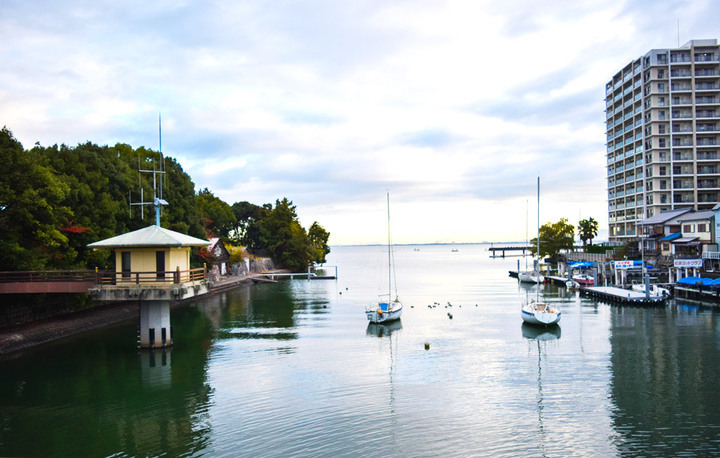
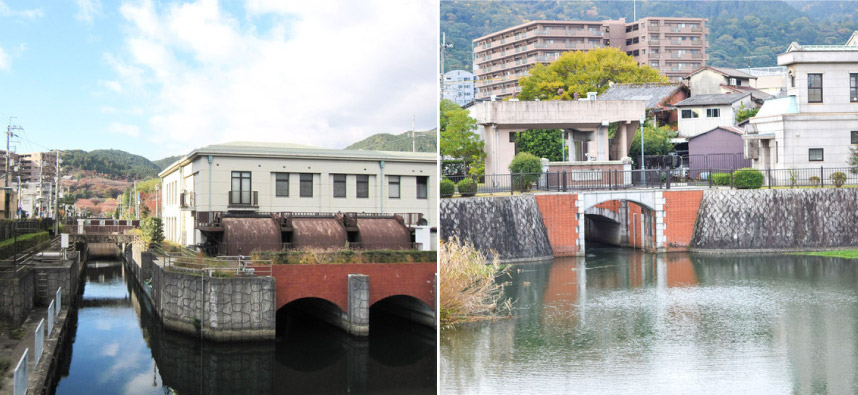
The First Canal Intake is used to intake water from the Lake Biwa to the First Canal.
The Second Canal Intake is the intake for the Second Canal where an underground tunnel was installed throughout. This was constructed in response to the increasing demand for water and electricity.
The tunnel has a decorated gate at its entrance, and there is a plaque with engraved writing by Kuninomiya Kuniyoshi (a prince of Japanese Imperial family). The phrase “Banbutsu torite hazumu” means that “This is the beginning of everything,” and it is a quote from an article in the “Book of Changes.”
This is the railroad bridge which was constructed for Keihan Electric Railway’s Ishiyama Sakamoto Line to cross the First Canal. The train will run right above the water route of the Lake Biwa Canal Cruise. So, if you are lucky, you might be able to see the train up from right below. This is the angle from which you normally rarely see the train. The Otsue Bridge, which is located on the western side of the railroad bridge and is spanning diagonally across the canal, is also a trace of the former Kojyaku Railway’s railroad bridge.
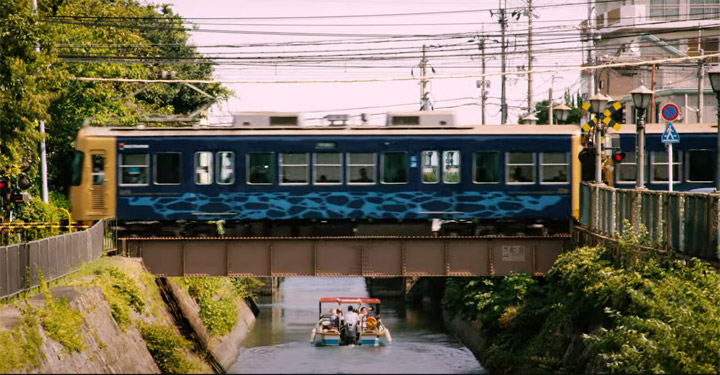
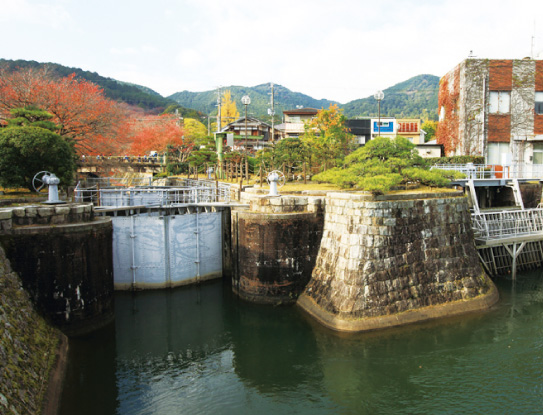
The Otsu Lock Gate is the facility which is used to adjust the difference of the water level between the Lake Biwa and the canal by opening and closing two water gates alternately. At the outset of the construction, the gate was wooden and opening and closing was controlled manually and required four people. Currently this gate is made of steel.
In 2021, renovation work for electrification completed and so manual opening and closing is not necessary anymore. However, for emergency operation, a handle for manual operation remains to this day.
The Otsu Lock Gate is one of the first full-fledged western style brick lock gate in Japan following the Ishii Lock Gate located on the Kitakami River in Miyagi prefecture. And this is also a valuable heritage of modernization.
In 2023, construction for automation of the lock gate completed.
In the cruise with extended route, you can now experience a change of the water level by opening and closing of the Lock Gate on the ship.
It is very impressive to see the moment when water flows from the gap of the Lock Gate.
Above the end arches of each tunnel, you will see a stone tablet sign with calligraphy on it, which is called hengaku in Japanese. With the calligraphy on each having different meanings, these hengakus hold great historical significance as they were all inscribed by politicians who defined the Meiji period.
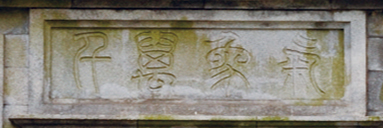
KISHO BANSEN
Meaning: The ever-changing scenery is magnificent
Written by: Hirobumi Ito (first prime minister of Japan)
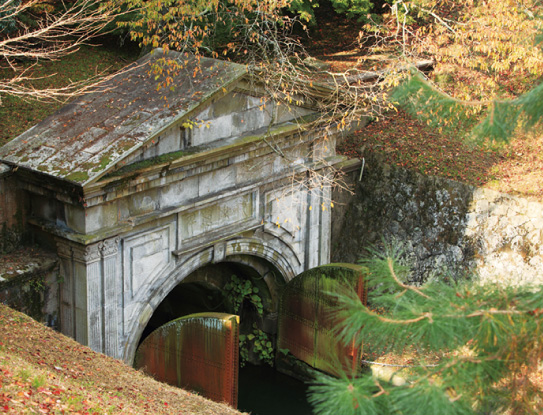
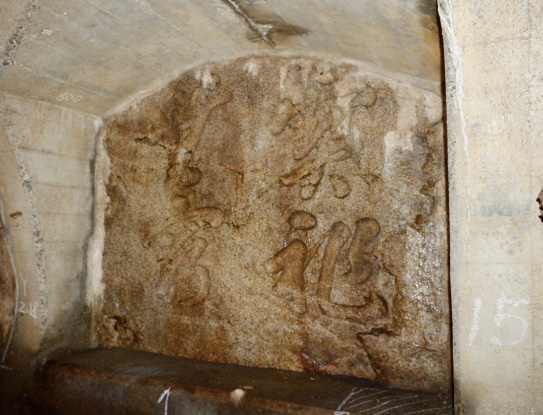
Kunimichi Kitagaki was the third governor of Kyoto Prefecture. In order to revive Kyoto which was suffering from economic decline following the relocation of the capital from Kyoto to Tokyo (which was one of the major measures taken during the Meiji Restoration), he implemented various measures to modernize it.
Of the many successful projects implemented by Kitagaki, one of the most representative was the planning and construction of Lake Biwa Canal.
HOUSO MUKYU
Meaning: The Imperial Throne is eternal
Written by: Kunimichi Kitagaki
※ The tablet is actually inside the tunnel and cannot be seen from the outside.
In order to excavate a tunnel stretching 2,436 meters, which was Japan’s longest at the time, while teams bored from both sides of the mountain, a vertical shaft was drilled downwards from the top of the mountain, enabling simultaneous boring from the center of the mountain towards both sides from the bottom of this shaft. This “shaft method” of excavation, which sped up the process, was a first for Japan. Overcoming strenuous challenges such as hard rock and large volumes of groundwater inflow, this shaft of depth 47 meters and a ground level diameter of 5.5 meters was finally completed.
※Access to the surrounding area is usually prohibited, but the shaft can be seen from the street.
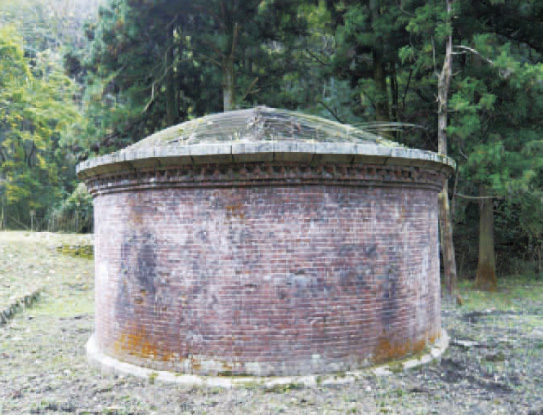
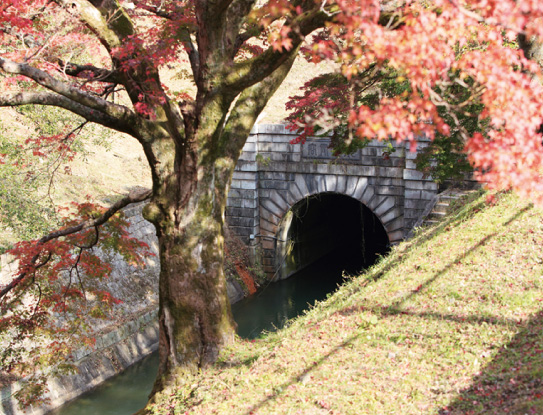
Above the west end of the First tunnel, there is a hengaku stone tablet inscribed by Aritomo Yamagata, Japan’s first foreign minister. The design of this arch is very similar to the design of the Troy and Greenfield Railroad’s Hoosac Tunnel in the United States (1874), so it is thought that Sakuro Tanabe has used it as a reference model.
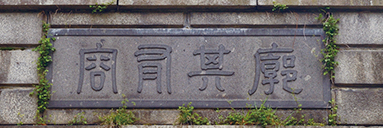
KAKUTOSHITE SOREIRURU KOTO ARI
Meaning: The earth, with a water filled canal, has depth and is spacious
Written by: Aritomo Yamagata
Learning from the disastrous Great Hanshin-Awaji Earthquake, an emergency closure gate was installed in 1999 in order to automatically shut off water flow in case of an embankment failure induced by a major earthquake. The bridge that lies past the emergency closure gate was the first bridge to be completed during the construction of the canal. The original construction of the base built of red brick and stone can still be seen today.
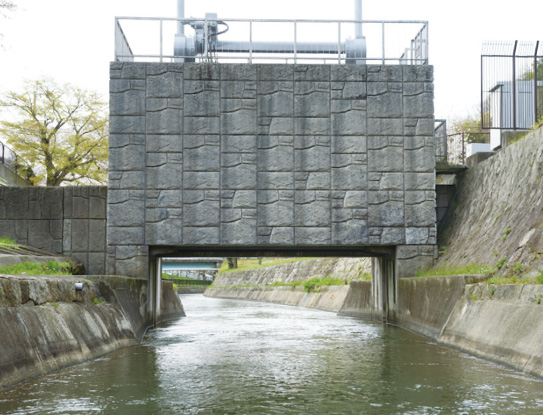
A funadamari is an anchoring area for boats to load and unload cargo and to allow passengers to embark and disembark. This was the first of its kind on the Otsu side and the area is well known for cherry blossoms in the spring. The entrance to the Moroha Tunnel (520 meters) built in 1970 during the construction of the JR Kosei Line is also located here.
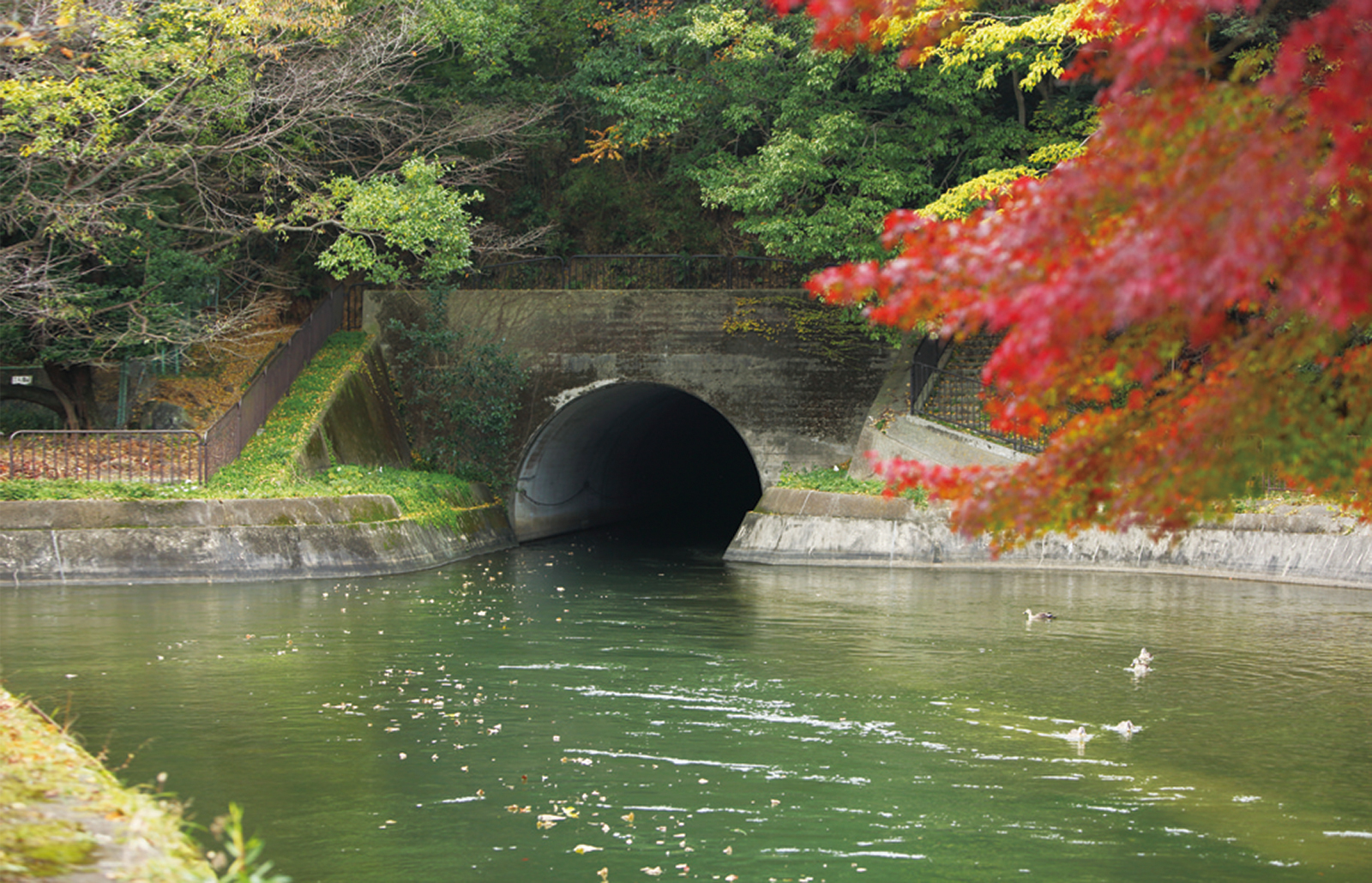
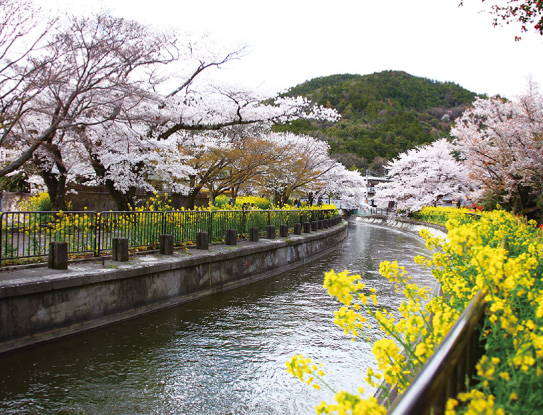
Anshu Bridge spans the approach to Bishamon-do Temple. The bridge is a famous spot for cherry blossoms in the spring, together with canola blossoms carefully tended by local residents. Further downstream, the Anshojigawa River which was orignally here before the canal’s construction can be seen flowing under the canal, creating a characteristic dual level intersection of water flow.
Here, you will be able to see an impressive bright vermillion bridge that crosses the canal diagonally. This bridge, together with the contrasting green of the maple leaves, leads to the Honkokuji Temple which is associated with the Buddhist monk Nichiren. Hongokuji was originally written in different Japanese characters, but came to be written in the current characters after lord Mitsukuni Tokugawa became a worshipper of the temple.
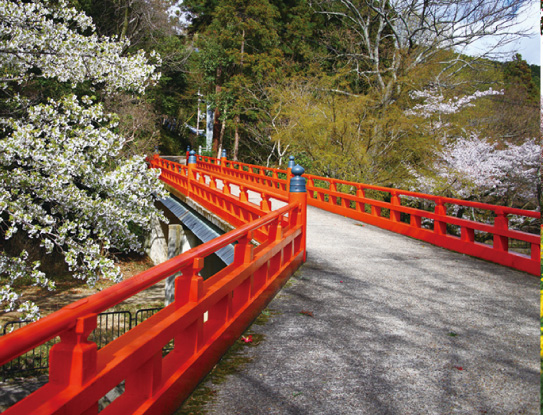
At 124 meters in length, Second tunnel is the shortest tunnel on the route. Of all the hengaku stone tablets in the first canal, the one with the most word count is the one on the east end of Second tunnel: Jin wa yama wo motte yorokobi, chi wa mizu no tame ni yorokobu, written by the first home secretary, Kaoru Inoue. At first glance, it looks as though the words are written from left to right across two lines, but they are actually written in four columns, from top to bottom, which sets this tablet apart from others.
The west end arch of this tunnel is not semi-circular like those of other tunnels, but is slightly pointed at the top. On this end is a hengaku tablet written by the Meiji government’s first navy minister Tsugumichi Saigo, which says “Yama ni shitagaite, suigen ni itaru.”
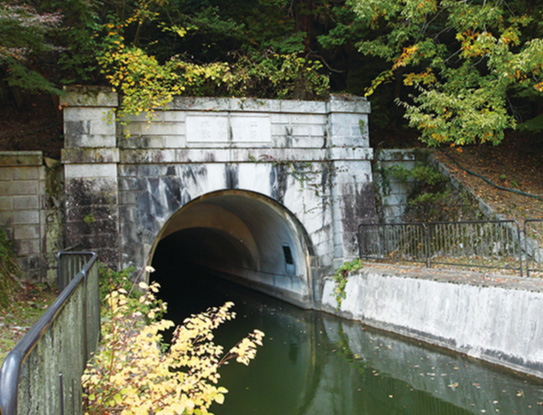
〈East end〉
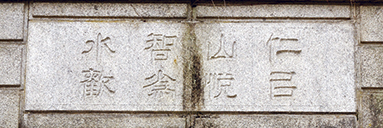
JIN WA YAMA WO MOTTE YOROKOBI, CHI WA MIZU NO TAME NI YOROKOBU
Meaning: Men of virtue are delighted by steadfast mountains; men of wisdom are delighted by flowing water
Written by: Kaoru Inoue
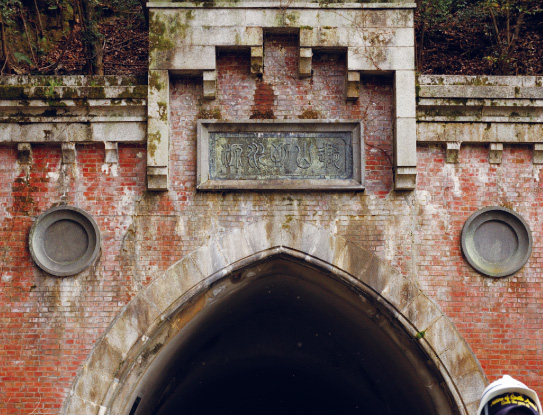
〈West end〉
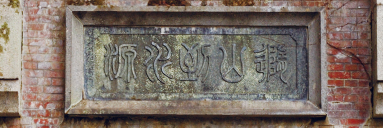
YAMA NI SHITAGAITE, SUIGEN NI ITARU
Meaning: If you proceed along(abide by) the mountains you will reach a water source
Written by: Tsugumichi Saigo
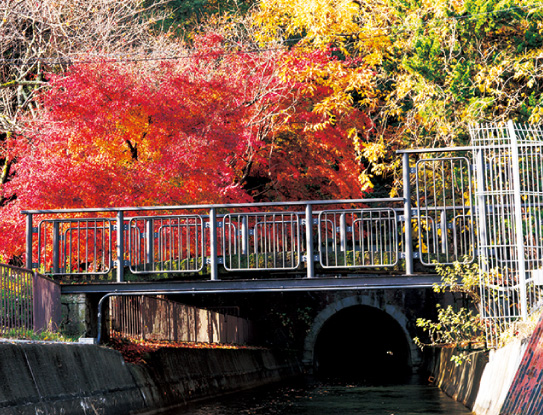
At first, this bridge appears to be completely ordinary. It was, however, Japan’s first reinforced concrete bridge, built by Sakuro Tanabe in 1903. A stone monument stands next to the bridge and is inscribed with words meaning “Our Country’s First Reinforced Concrete Bridge.”
Third tunnel, which is located just downstream of 11th bridge, is 850 meters long.
On the eastern end of the tunnel, there is a stone tablet saying “Kau shoshoku wo miru,” written by Masayoshi Matsukata, who was the first minister of finance. On the western end is a tablet saying“Uruwashikikana sanga,” written by Sanutomi Sanjo who was Japan’s first Lord Keeper of the Privy Seal after the cabinet system was inaugurated. Next to the west end of the tunnel is the Keage Embarkation Area. One of its main attractions is the pump room for the water supply to the former Imperial Palace, which we will touch upon next.
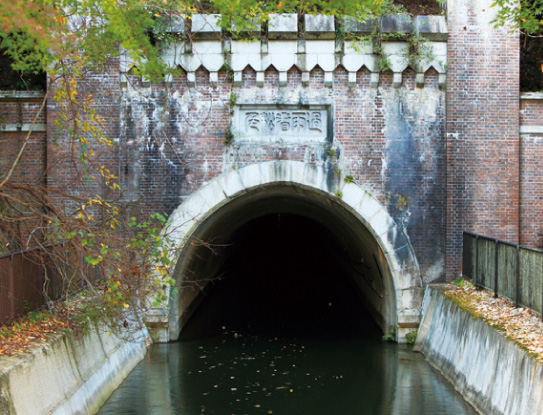
〈East end〉
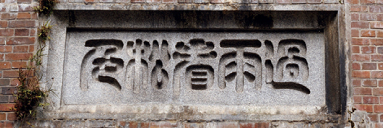
KAU SHOUSHOKU WO MIRU
Meaning: When the rain shower passes, you can see the more vivid green of the pines
Written by: Masayoshi Matsukata
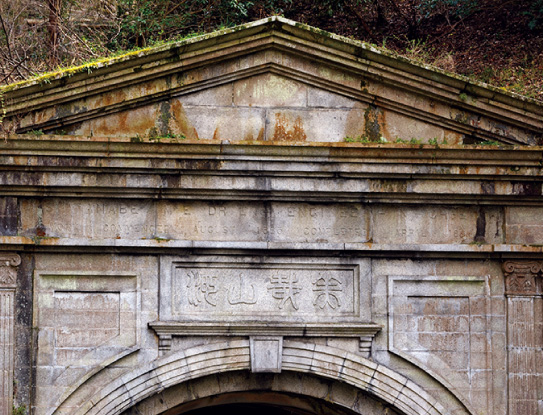
〈West end〉
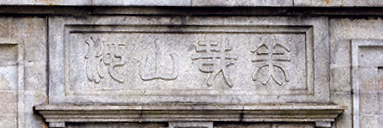
URUWASHIKIKANA SANGA
Meaning: What a beautiful mountain river
Written by: Sanutomi Sanjo
“Imperial Palace Water Works System” was used to supply water exclusively to the palace for fire prevention purposes. The pump room sent water to a reservoir atop the mountain behind the palace so that water could be sprayed down, if need be, onto the roof of the Hall for State Ceremonies, which was the tallest building in the Imperial Palace grounds. The pump room was designed by Tokuma Katayama, the architect who is known for designing Kyoto National Museum, and built by the Imperial Household Agency.
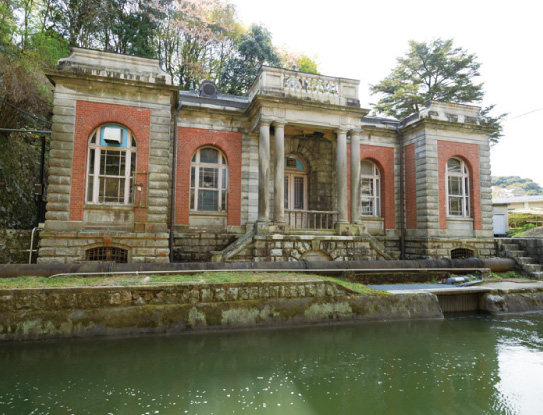
More attractions
along Lake Biwa Canal
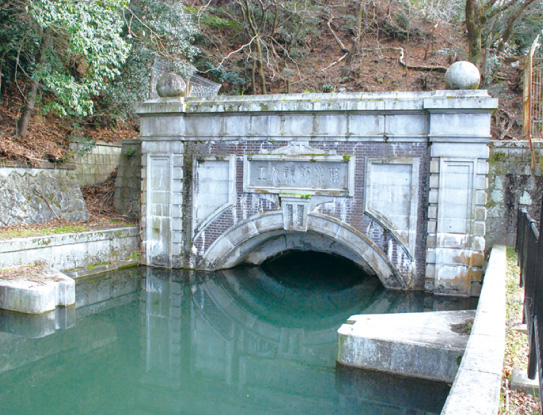
A stone tablet written by Sakuro Tanabe can be found above the canal’s confluence tunnel. At the age of 21, Tanabe, a fresh graduate from Kobu University (today, the Faculty of Engineering, Tokyo University) was appointed Chief Engineer for the construction of Lake Biwa Canal by governor Kitagaki.
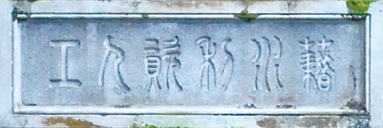
SUIRI WO KARITE JINKO WO TASUKU
Meaning: The bountiful power of nature’s water shall be utilized for human work
Written by: Sakuro Tanabe




































